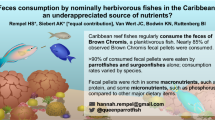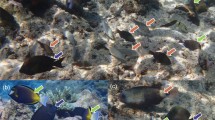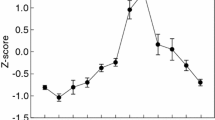Abstract
Herbivorous fishes are an important component of coral reef systems worldwide, but their nutritional ecology is poorly understood, particularly the relationships between the taxonomic composition and the nutritional composition of their diets. We compared dietary composition with % carbon, % nitrogen and C:N ratios of diet in four species of nominally herbivorous fishes from the Southwestern Atlantic and used literature values to calculate proportional contributions of dietary items to total nitrogen intake. Both Sparisoma axillare (Labridae, Scarinae) and Acanthurus chirurgus (Acanthuridae) had a diet composed mainly of detritus, with contributions of red algae. However, the diet of S. axillare displayed higher %N and a lower C:N ratio, although animal material made only a slightly greater contribution to total nitrogen intake than in A. chirurgus. Kyphosus sectatrix (Kyphosidae) ingested mainly carbon-rich corticated algae, while Diplodus argenteus (Sparidae) had a varied, omnivorous diet. These results indicate that conventional diet analysis may not reveal important interspecific differences in nutrient intake and that a reassessment of the nutrient intake of different herbivorous fishes is required to fully understand their ecology. This finding highlights the fact that foods of nominally herbivorous fishes vary greatly in nutritional quality. Moreover, conventional dietary categories such as detritus may exhibit considerable heterogeneity in taxonomic and nutritional composition, suggesting a previously unrecognised level of dietary selectivity in this fish assemblage.



Similar content being viewed by others
Change history
27 November 2018
The authors would like to correct the error in the publication of the original article. The corrected details are given below for your reading.
References
Adam TC, Burkepile DE, Ruttenberg BI, Paddack MJ (2015) Herbivory and the resilience of Caribbean coral reefs: knowledge gaps and implications for management. Mar Ecol Prog Ser 520:1–20. https://doi.org/10.3354/meps11170
Angell AR, Mata L, de Nys R, Paul NA (2015) The protein content of seaweeds: a universal nitrogen-to-protein conversion factor of five. J Appl Phycol 28:511–524. https://doi.org/10.1007/s10811-015-0650-1
Barbarino E, Lourenço SO (2009) Comparison of CHN analysis and Hach acid digestion to quantify total nitrogen in marine organisms. Limnol Oceanogr Methods 7:751–760. https://doi.org/10.4319/lom.2009.7.751
Bellwood DR, Hughes TP, Folke C, Nyström M (2004) Confronting the coral reef crisis. Nature 429:827–833. https://doi.org/10.1038/nature02691
Bierwagen SL, Heupel MR, Chin A, Simpfendorfer CA (2018) Trophodynamics as a tool for understanding coral reef ecosystems. Front Mar Sci 5:24. https://doi.org/10.3389/fmars.2018.00024
Bjorndal KA (1997) Fermentation in reptiles and amphibians. In: Mackie RI, White BA (eds) Gastrointestinal microbiology, vol 1. Gastrointestinal ecosystems and fermentations. Chapman & Hall, New York, pp 199–230
Bonaldo RM, Krajewski JP, Sazima C, Sazima I (2006) Foraging activity and resource use by three parrotfish species at Fernando de Noronha Archipelago, tropical West Atlantic. Mar Biol 149:423–433. https://doi.org/10.1007/s00227-005-0233-9
Bonaldo RM, Hoey AS, Bellwood DR (2014) The ecosystem roles of parrotfishes on tropical reefs. Oceanogr Mar Biol Annu Rev 52:81–132
Burkepile DE, Hay ME (2006) Herbivore vs. nutrient control of marine primary producers: context-dependent effects. Ecology 87:3128–3139. https://doi.org/10.1890/0012-9658(2006)87%5b3128:HVNCOM%5d2.0.CO;2
Burkholder PD, Burkholder LM, Almodovar LR (1971) Nutritive constituents of some Caribbean marine algae. Bot Mar 14:132–135. https://doi.org/10.1515/botm.1971.14.2.132
Carpenter RC (1986) Partitioning herbivory and its effects on coral reef algal communities. Ecol Monogr 56:345–364
Carr A, Tibbetts IR, Kemp A, Truss R, Drennan J (2006) Inferring parrotfish (Teleostei: Scaridae) pharyngeal mill function from dental morphology, wear, and microstructure. J Morph 267:1147–1156. https://doi.org/10.1002/jmor.10457
Choat JH, Clements KD (1998) Vertebrate herbivory in marine and terrestrial environments: a nutritional ecology perspective. Annu Rev Ecol Syst 29:375–403. https://doi.org/10.1146/annurev.ecolsys.29.1.375
Choat JH, Clements KD, Robbins WD (2002) The trophic status of herbivorous fishes on coral reefs 1: dietary analyses. Mar Biol 140:613–623. https://doi.org/10.1007/s00227-001-0715-3
Choat JH, Robbins WD, Clements KD (2004) The trophic status of herbivorous fishes on coral reefs. II. Food processing modes and trophodynamics. Mar Biol 145:445–454. https://doi.org/10.1007/s00227-004-1341-7
Clements KD, Choat JH (1997) Comparison of herbivory in the closely-related marine fish genera Girella and Kyphosus. Mar Biol 127:579–586. https://doi.org/10.1007/s002270050048
Clements KD, Choat JH (2018) Nutritional ecology of parrotfishes (Scarinae, Labridae). In: Hoey AS, Bonaldo RM (eds) The biology and ecology of parrotfishes. CRC, Boca Raton, pp 42–68
Clements KD, Raubenheimer D, Choat JH (2009) Nutritional ecology of marine herbivorous fishes: ten years on. Funct Ecol 23:79–92. https://doi.org/10.1111/j.1365-2435.2008.01524.x
Clements KD, German DP, Piché J, Tribollet A, Choat JH (2017) Integrating ecological roles and trophic diversification on coral reefs: multiple lines of evidence identify parrotfishes as microphages. Biol J Linnean Soc 120:729–751. https://doi.org/10.1111/bij.12914
Cordeiro CAMM, Mendes TC, Harborne AR, Ferreira CEL (2016) Spatial distribution of nominally herbivorous fishes across environmental gradients on Brazilian rocky reefs. J Fish Biol 89:939–958. https://doi.org/10.1111/jfb.12849
Crossman DJ, Choat JH, Clements KD et al (2001) Detritus as food for grazing fishes on coral reefs. Limnol Oceanogr 46:1596–1605. https://doi.org/10.4319/lo.2001.46.7.1596
Crossman DJ, Choat JH, Clements KD (2005) Nutritional ecology of nominally herbivorous fishes on coral reefs. Mar Ecol Prog Ser 296:129–142. https://doi.org/10.3354/meps296129
Diniz GS, Barbarino E, Lourenço SO (2012) On the chemical profile of marine organisms from coastal subtropical environments: gross composition and nitrogen-to-protein conversion factors. In: Marcelli M (ed) Oceanography. InTech, Zagreb, pp 297–320
Diniz GS, Barbarino E, Oiano-Neto J et al (2014) Proximate composition of marine invertebrates from tropical coastal waters, with emphasis on the relationship between nitrogen and protein contents. Lat Am J Aquat Res 42:332–352. https://doi.org/10.3856/vol42-issue2-fulltext-5
Dromard CR, Bouchon-Navaro Y, Harmelin-Vivien M, Bouchon C (2015) Diversity of trophic niches among herbivorous fishes on a Caribbean reef (Guadeloupe, Lesser Antilles), evidenced by stable isotope and gut content analyses. J Sea Res 95:124–131. https://doi.org/10.1016/j.seares.2014.07.014
Dubiaski-Silva J, Masunari S (2006) Ontogenetic and seasonal variation in the diet of Marimbá, Diplodus argenteus (Valenciennes, 1830) (Pisces, Sparidae) associated with the beds of Sargassum cymosum C. Agardh, 1820 (Phaeophyta) at Ponta das Garoupas, Bombinhas, Santa Catarina. J Coast Res SI 39:1190–1192
Duncan P, Foose TJ, Gordon IJ, Gakahu CG, Lloyd M (1990) Comparative nutrient extraction from forages by grazing bovids and equids: a test of the nutritional model of equid/bovid competition and coexistence. Oecologia 84:411–418
Edwards PB (1991) Seasonal variation in the dung of African grazing mammals, and its consequences for coprophagous insects. Func Ecol 5:617–628
Fernández I, Moyano FJ, Díaz M, Martínez T (2001) Characterization of & α-amylase activity in five species of Mediterranean sparid fishes (Sparidae, Teleostei). J Exp Mar Biol Ecol 262:1–12
Ferreira CEL, Gonçalves JEA (2006) Community structure and diet of roving herbivorous reef fishes in the Abrolhos Archipelago, south-western Atlantic. J Fish Biol 69:1533–1551. https://doi.org/10.1111/j.1095-8649.2006.01220.x
Ferreira CEL, Gonçalves JEA, Coutinho R, Peret AC (1998a) Herbivory by the dusky damselfish Stegastes fuscus (Cuvier, 1830) in a tropical rocky shore: effects on the benthic community. J Exp Mar Bio Ecol 229:241–264. https://doi.org/10.1016/S0022-0981(98)00056-2
Ferreira CEL, Peret AC, Coutinho R (1998b) Seasonal grazing rates and food processing by tropical herbivorous fishes. J Fish Biol 53:222–235. https://doi.org/10.1111/j.1095-8649.1998.tb01029.x
Ferreira CEL, Gonçalves JEA, Coutinho R (2001) Community structure of fishes and habitat complexity on a tropical rocky shore. Environ Biol Fishes 61:353–369. https://doi.org/10.1023/A:1011609617330
Ferreira CEL, Floeter SR, Gasparini JL et al (2004) Trophic structure patterns of Brazilian reef fishes: a latitudinal comparison. J Biogeogr 31:1093–1106. https://doi.org/10.1111/j.1365-2699.2004.01044.x
Fidopiastis PM, Bezdek DJ, Horn MH, Kandel JS (2006) Characterizing the resident, fermentative microbial consortium in the hindgut of the temperate-zone herbivorous fish, Hermosilla azurea (Teleostei: Kyphosidae). Mar Biol 148:631–642. https://doi.org/10.1007/s00227-005-0106-2
Floeter SR, Behrens MD, Ferreira CEL et al (2005) Geographical gradients of marine herbivorous fishes: patterns and processes. Mar Biol 147:1435–1447. https://doi.org/10.1007/s00227-005-0027-0
Francini-Filho RB, Ferreira CM, Coni EOC, Moura RL, Kaufman L (2010) Foraging activity of roving herbivorous reef fish (Acanthuridae and Scaridae) in eastern Brazil: influence of resource availability and interference competition. J Mar Biol Assoc UK 90:481–492. https://doi.org/10.1017/S0025315409991147
Freudenberger DO, Walli IR, Hume ID (1989) Digestive adaptations of kangaroos, wallabies and rat-kangaroos. In: Grigg G, Jarman P, Hume ID (eds) Kangaroos, wallabies and rat-kangaroos. Surrey Beatty & Sons Pty Ltd, New South Wales, pp 179–187
Green AL, Bellwood DR (2009) Monitoring functional groups of herbivorous fishes as indicators for coral reef resilience. In: IUCN working group on climate change and coral reefs
Guimaraes MA, Coutinho R (1996) Spatial and temporal variation of benthic marine algae at the Cabo Frio upwelling region, Rio de Janeiro, Brazil. Aquat Bot 52:283–299. https://doi.org/10.1016/0304-3770(95)00511-0
Holley LL, Heidman MK, Chambers RM, Sanderson SL (2015) Mucous contribution to gut nutrient content in American gizzard shad Dorosoma cepedianum. J Fish Biol 86:1457–1470. https://doi.org/10.1111/jfb.12656
Horn MH (1989) Biology of marine herbivorous fishes. Oceanogr Mar Biol 27:167–272
Hume ID (1999) Marsupial nutrition. Cambridge University Press, Cambridge, p 450
Hundt PJ, Simons AM (2018) Extreme dentition does not prevent diet and tooth diversification within combtooth blennies (ovalentaria: Blenniidae). Evolution. https://doi.org/10.1011/evo.13453
Kelly JR, Scheibling RE (2012) Fatty acids as dietary tracers in benthic food webs. Mar Ecol Prog Ser 466:1–22. https://doi.org/10.3354/meps09559
Kulbicki M, Parravicini V, Bellwood DR et al (2013) Global biogeography of reef fishes: a hierarchical quantitative delineation of regions. PLoS One 8:e81847. https://doi.org/10.1371/journal.pone.0081847
Lartigue J, Cebrian J (2012) Ecosystem productivity and carbon flows: patterns across ecosystems. In: Levin SA, Carpenter SR, Godfray HCJ (eds) The Princeton guide to ecology. Princeton University Press, Princeton, pp 320–329
Levey DJ, Martínez del Rio C (2001) It takes guts (and more) to eat fruit: lessons from avian nutritional ecology. Auk 118:819–831. https://doi.org/10.2307/4089834
Littler MM, Taylor PR, Littler DS (1983) Algal resistance to herbivory on a Caribbean barrier reef. Coral Reefs 2:111–118
Lobato FL, Barneche DR, Siqueira AC et al (2014) Diet and diversification in the evolution of coral reef fishes. PLoS One 9:e102094. https://doi.org/10.1371/journal.pone.0102094
Longo GO, Ferreira CEL, Floeter SR (2014) Herbivory drives large-scale spatial variation in reef fish trophic interaction. Ecol Evol 4:4553–4566. https://doi.org/10.1002/ece3.1310
McDermid KJ, Stuercke B, Balazs GH (2007) Nutritional composition of marine plants in the diet of the green sea turtle (Chelonia mydas) in the Hawaiian Islands. Bull Mar Sci 81:55–71
McMahon KW, Thorrold SR, Houghton LA, Berumen LM (2016) Tracing carbon flow through coral reef food webs using a compound-specific stable isotope approach. Oecol 180:809–821
Mendes TC, Villaça RC, Ferreira CEL (2009) Diet and trophic plasticity of an herbivorous blenny Scartella cristata of subtropical rocky shores. J Fish Biol 75:1816–1830. https://doi.org/10.1111/j.1095-8649.2009.02434.x
Mendes TC, Cordeiro CAMM, Ferreira CEL (2015) An experimental evaluation of macroalgal consumption and selectivity by nominally herbivorous fishes on subtropical rocky reefs. J Exp Mar Biol Ecol 471:146–152. https://doi.org/10.1016/j.jembe.2015.06.001
Montgomery WL, Gerking SD (1980) Marine macroalgae as food for fishes: an evaluation of potential food quality. Environ Biol Fish 5:143–153
Mountfort DO, Campbell J, Clements KD (2002) Hindgut fermentation in three species of marine herbivorous fish. Appl Environ Microbiol 68:1374–1380. https://doi.org/10.1128/AEM.68.3.1374-1380.2002
Munda IK, Gubenšek F (1976) The amino acid composition of some common marine algae from Iceland. Bot Mar 19:85–92
Oksanen J, Blanchet FG, Friendly M, Kindt R, Legendre P, McGlinn D, Minchin PR, O’Hara RB, Simpson GL, Solymos P, Stevens HH, Szoecs E, Wagner H (2017) vegan: community ecology package. R package version 2.4-5. https://CRAN.R-project.org/package=vegan
Paine R (1996) Food web complexity and community dynamics. Am Nat 100:65–75
Phleger CF, Laub RJ (1989) Skeletal fatty acids in fish from different depths off Jamaica. Comp Biochem Physiol B Biochem Mol Biol 94:329–334
Piché J, Iverson SJ, Parrish FA, Dollar R (2010) Characterization of forage fish and invertebrates in the Northwestern Hawaiian Islands using fatty acids signatures: species and ecological groups. Mar Ecol Prog Ser 418:1–15
Randall JE (1967) Food habits of reef fishes of the West Indies. Stud Trop Oceanogr 5:665–847
Raubenheimer D, Simpson SJ, Mayntz D (2009) Nutrition, ecology and nutritional ecology: toward an intergrated framework. Funct Ecol 23:4–16. https://doi.org/10.1111/j.1365-2435.2008.01522.x
Rogers R, Correal G, Oliveira TC et al (2014) Coral health rapid assessment in marginal reef sites. Mar Biol Res 10:612–624. https://doi.org/10.1080/17451000.2013.841944
Rooney N, McCann K, Gellner G, Moore JC (2006) Structural asymmetry and the stability of diverse food webs. Nature 442:265–269. https://doi.org/10.1038/nature04887
Sheaves M, Sheaves J, Stegemann K, Molony B (2014) Resources partitioning and habitat-specific dietary plasticity of two estuarine sparid fishes increases food-web complexity. Mar Freshw Res 65:114–123
Smith JE, Smith CM, Hunter CL (2001) An experimental analysis of the effects of herbivory and nutrient enrichment on benthic community dynamics on a Hawaiian reef. Coral Reefs 19:332–342. https://doi.org/10.1007/s003380000124
Soares F, Freitas R, Soares J, Leitão F, Cristo M (2012) Feeding ecology and morphometric relationships of white seabream, Diplodus sargus lineatus (Sparidae), endemic species of Cape Verde. Cybium 36:461–472
Steneck RS, Dethier MN (1994) A functional group approach to the structure of algal-dominated communities. Oikos 69:476–498. https://doi.org/10.2307/3545860
Tâmega FTS, Figueiredo MAO, Ferreira CEL, Bonaldo RM (2016) Seaweed survival after consumption by the greenbeak parrotfish Scarus trispinosus. Coral Reefs 35:329–334
R Core Team (2017) R: a language and environment for statistical computing. R Foundation for Statistical Computing, Vienna, Austria. https://www.R-project.org/
Tramati C, Savona B, Mazzola A (2005) A study of the pattern of digestive enzymes in Diplodus puntazzo (Cetti, 1777) (Osteichthyes, Sparidae): evidence for the definition of nutritional protocols. Aquacult Int 13:89–95
Valentin JL (1984) Analyse des paramètres hydrobiologiques dans la remontée de Cabo Frio (Brésil). Mar Biol 82:259–276. https://doi.org/10.1007/BF00392407
Van Soest P (1994) Nutritional ecology of the ruminants, 2nd edn. Cornell Press, Ithaca
Villaça R, Yoneshigue-Valentin Y, Boudouresque CF (2008) Estrutura da comunidade de macroalgas do infralitoral do lado exposto da ilha de Cabo Frio (Arraial Do Cabo, RJ). Oecol Bras 12:206–221
Wallace RK (1981) An assessment of diet-overlap indexes. Trans Am Fish Soc 110:72–76
Weber JM, Haman G (1996) Pathways for metabolic fuels and oxygen in high performance fish. Com Biochem Physiol 113:33–38
Wheeler B, Torchiano M (2016) lmPerm: permutation tests for linear models. R package version 2.1.0. https://CRAN.R-project.org/package=lmPerm
White WL, Coveny AH, Robertson J, Clements KD (2010) Utilisation of mannitol by temperate marine herbivorous fishes. J Exp Mar Biol Ecol 391:50–56. https://doi.org/10.1016/j.jembe.2010.06.007
Wilson SK, Bellwood DR, Choat JH, Furnas MJ (2003) Detritus in the epilithic algal matrix and its use by coral reef fishes. Oceanogr Mar Biol Annu Rev 41:279–309
Yamamuro M (1999) Importance of epiphytic cyanobacteria as food sources for heterotrophs in a tropical seagrass bed. Coral Reefs 18:263–271. https://doi.org/10.1007/s003380050191
Zemke-White WL, Clements KD, Harris PJ (2000) Acid lysis of macroalgae by marine herbivorous fishes: effects of acid pH on cell wall porosity. J Exp Mar Biol Ecol 245:57–68. https://doi.org/10.1016/S0022-0981(99)00151-3
Zemke-White WL, Choat JH, Clements KD (2002) A re-evaluation of the diel feeding hypothesis for marine herbivorous fishes. Mar Biol 141:571–579. https://doi.org/10.1007/s00227-002-0849-y
Zhang J (2016) spaa: SPecies Association Analysis. R package version 0.2.2. https://CRAN.R-project.org/package=spaa
Acknowledgements
We thank Cesar Cordeiro who helped collecting the fishes; and Howard Choat, Roberta Bonaldo and Cesar Cordeiro for helpful discussions. We also thank three anonymous reviewers and the handling editor for valuable comments on this paper.
Funding
Financial support was given by FAPERJ (through a visiting professor grant to KDC—APV#E-26/111.654/2012), CNPq (with a Sanduíche Scholarship to TCM—# 246840/2012-9), Fundação O Boticário de Proteção à Natureza (Grant #0898/20111) and ECOHUB that provides continuous support to LECAR activities.
Author information
Authors and Affiliations
Corresponding author
Ethics declarations
Conflict of interest
The authors declare that they have no conflict of interest.
Ethical approval
All collections were performed under environmental and ethical permits of responsible agencies (ICMBIO permit #46271).
Additional information
Responsible Editor: C. Harrod.
Reviewed by Undisclosed experts.
Electronic supplementary material
Below is the link to the electronic supplementary material.
Rights and permissions
About this article
Cite this article
Mendes, T.C., Ferreira, C.E.L. & Clements, K.D. Discordance between diet analysis and dietary macronutrient content in four nominally herbivorous fishes from the Southwestern Atlantic. Mar Biol 165, 180 (2018). https://doi.org/10.1007/s00227-018-3438-4
Received:
Accepted:
Published:
DOI: https://doi.org/10.1007/s00227-018-3438-4




